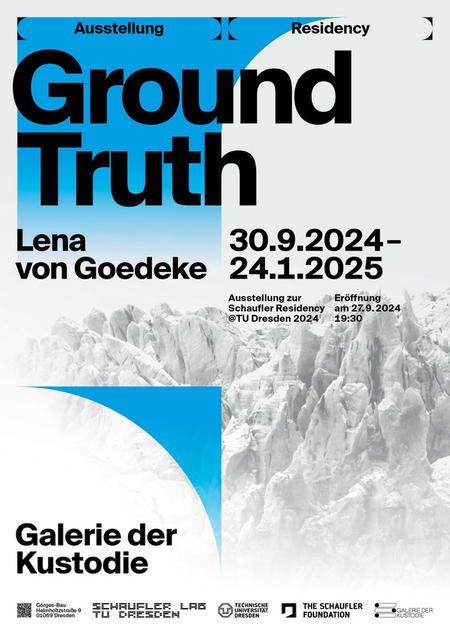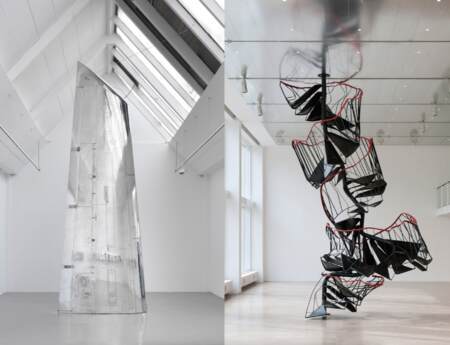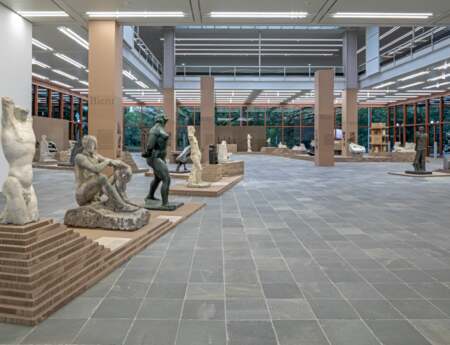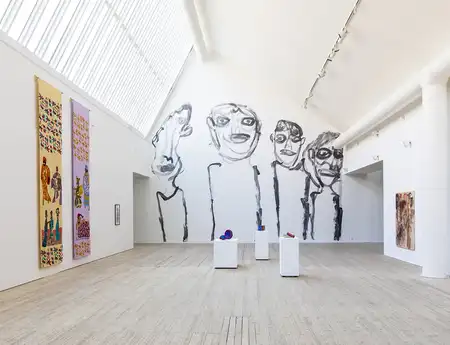Gallery of the Office for Academic Heritage at Görges-Bau
Helmholtzstraße 9
01069 Dresden
Deutschland
Lena von Goedeke: GROUND TRUTH
From May to October 2024, the internationally successful and award-winning sculptor and conceptual artist Lena von Goedeke (born 1983 in Duisburg, situated in Berlin and Longyearbyen, Spitsbergen) is artist in residence at Schaufler Lab@TU Dresden. Her exhibition GROUND TRUTH with around 15 works and series that were created over the past four years provides an insight into her collaborative research.
In recent years, von Goedeke has observed and accompanied the work of scientists conducting research at one of the northernmost points on earth. Remote sensing by satellite is the method of choice when it comes to collecting comprehensive information about the vast areas of the Arctic and to shedding light on movements or fluctuations of sea-ice areas, etc. These data from space help us better understand ongoing climate processes in the polar region.
At TUD Dresden University of Technology, Lena von Goedeke has had intensive discussions with cultural and humanities scholars, geologists, geodesists and geoinformaticians about the ethical and technological side effects of generating world images in this way. Our idea of the Arctic sea and ecosystem is shaped by these digital images from the air, recordings from sensors or through microscopes but also transformed into a second reality of media images.
The artist has immediate experience of disappearing landscapes and eroding coasts, which not only threaten but destroy entire habitats. Looking at the discrepancy between ever-growing volumes of data and images of the Arctic on the one hand and the simultaneous disappearance of physical landscapes on the other, she writes:
"What is needed is an understanding of responsibility—an opportunity for everyone to form their own opinion and to locate themselves. Without orientation there can be no connection to one's own habitat; without a feeling of being part of a system there can be no concern for it. Google Earth, after all, is not a habitable place. If looking out into space has been obscured and the view from space has become too artificial, what do we need to feel responsible for our planet?"
At Schaufler Lab@TU Dresden, Lena von Goedeke has intensely studied the fragility and volatility of materialised data memories such as rocks, fossils, and permafrost. The title of her exhibition, GROUND TRUTH, thus not only denotes an irrefutable or fundamental truth. As a technical term from remote sensing it also refers to the need to compare data garnered this way with data from field surveys (soil samples, photos, vegetation identification, etc.).
The heart of the exhibition is a group of works titled Trümmer (Debris), created in 2023-24: Four sculptures reminiscent of branches lie on displays; their surface is finely grained; pores, knotholes, and annual rings become visible. Looking longer at them, we notice that the texture of the branches changes. Trümmer consists of permafrost, i.e. frozen ground, whose structure dissolves within hours and turns into mud, which is then collected again. The setting includes an impressive icebox in which the moist soil material freezes in moulds before again being subjected to the process of melting. In the scenario conceived by Goedeke, we observe a physical cycle, guaranteed solely by the electricity-powered freezer. But how stable is the Arctic’s physical state?
Goedeke's long-exposure photograph Mouches Volantes (2023), taken in the Adventdalen valley on Spitsbergen, directs our gaze from the ground to the firmament. In winter, not only the starry sky can be seen here every night, but also around 800 satellites that slice the sky into a geometric grid and send their data to the radar system at 78 degrees latitude, near the location where the picture is taken. Data from the fragile surface of the earth are continuously collected and transmitted to high-performance computing stations by remote sensing satellites, whose dense artificial network in the sky prevents us from perceiving the vastness of space.
"But what happens to our planetary self-image when individuals can no longer locate themselves within the universe by looking at a wonderful starry sky? Is collecting all these images worth it?"
The artist’s poetic, and at the same time analytical, sculptures, installations as well as film and photographic works powerfully visualise the material and haptic dimension of the North Polar region by making it physically tangible. The image worlds of, on the one hand, remote sensing technologies and, on the other, permafrost mud could hardly be more different. What becomes clear from Lena von Goedeke's work is that we need to merge these world-pictures if we wish to confront the ‘extreme futures’ (Orit Halpern) with the duality of data and material.
About the artist
Lena von Goedeke was born in Duisburg in 1983 and now lives and works in Berlin and Spitsbergen. Her installations and objects have been shown at the Museum Marta Herford, the Museum August Macke Haus in Bonn, the Kunsthalle Münster and in numerous gallery exhibitions. Von Goedeke has already been awarded various prizes such as the Kallmann Prize of the Kallmann Museum Ismaning and the DEW21 Art Prize Dortmund as well as the annual scholarship of the Stiftung Kunstfonds.



